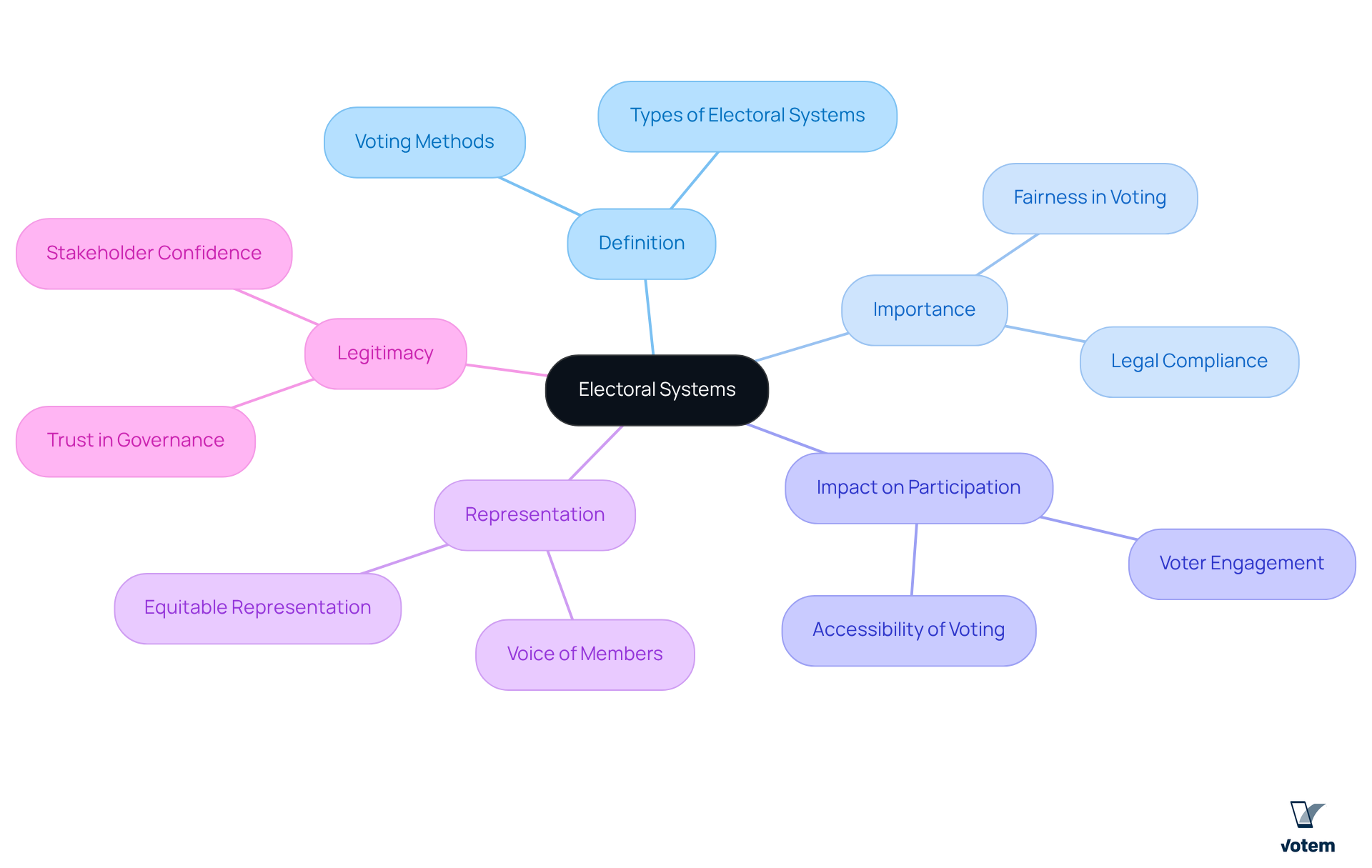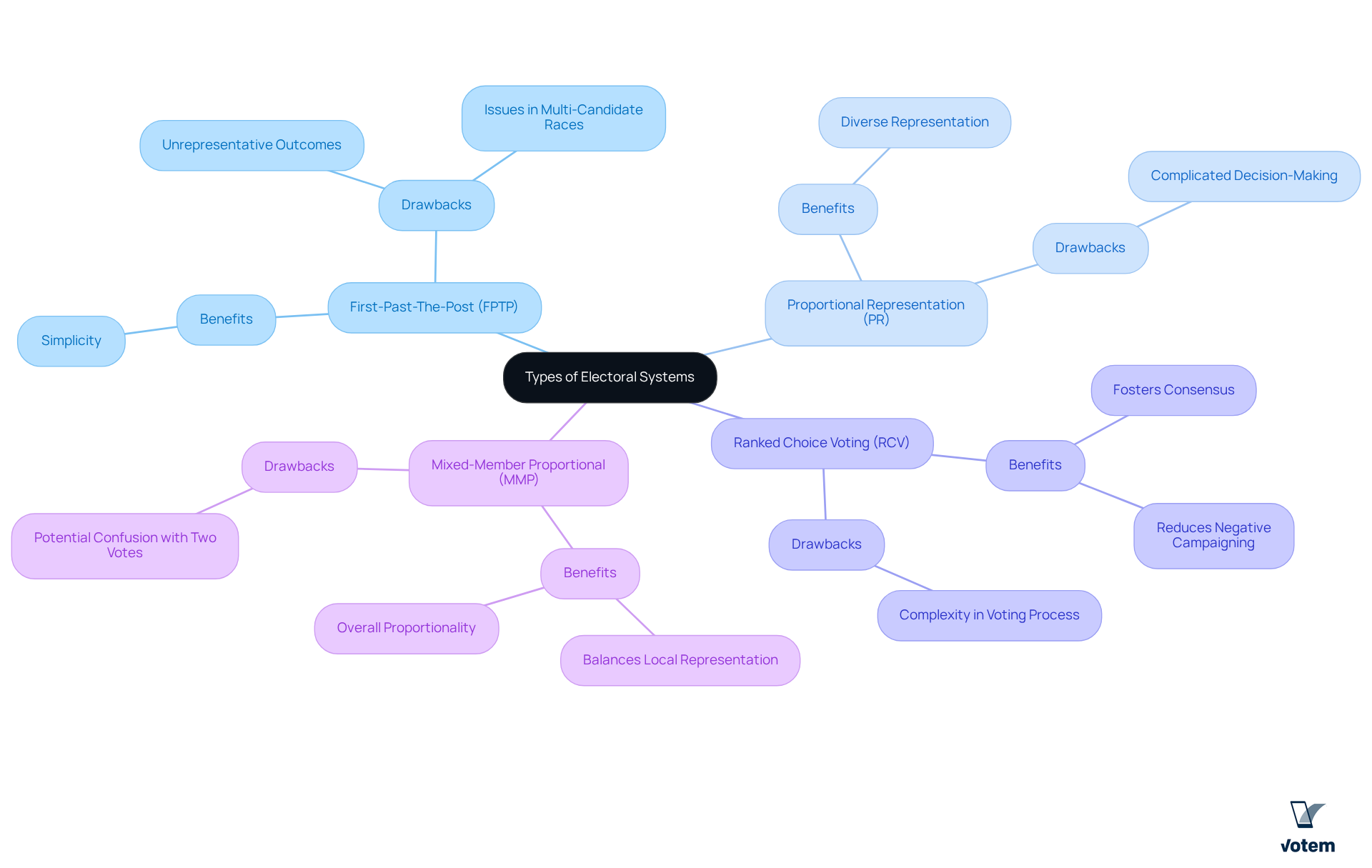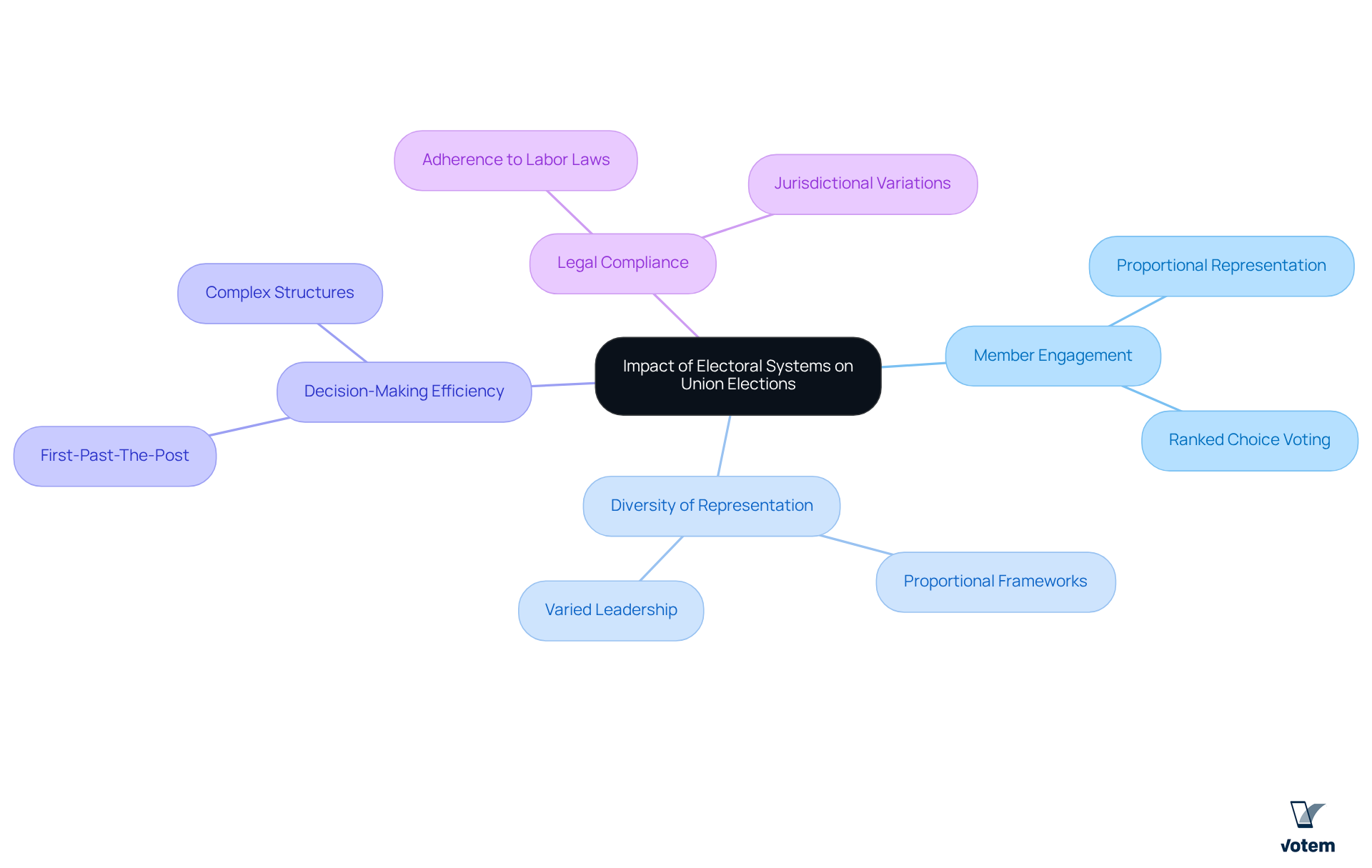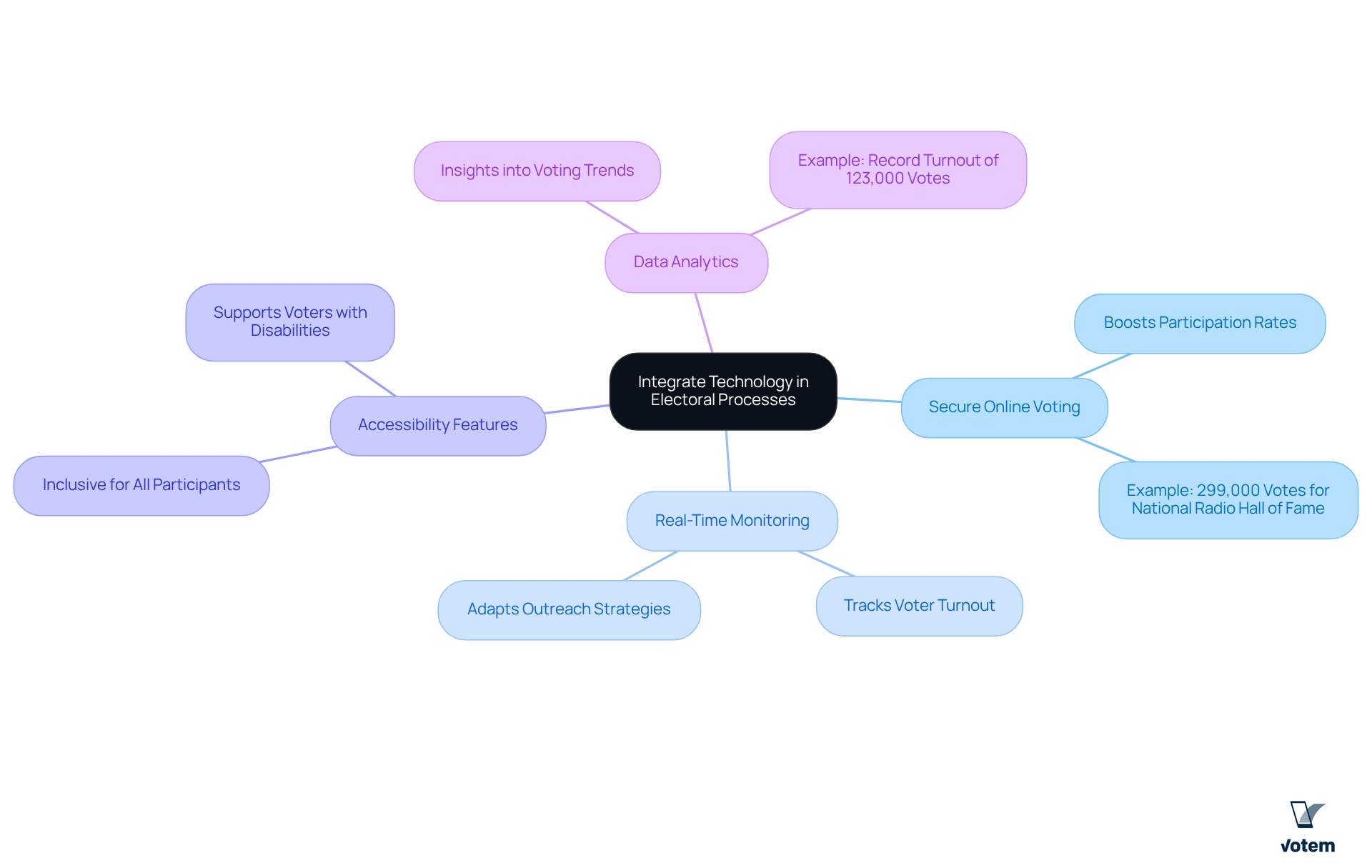Overview
The article examines the various types of electoral systems and their critical significance for union leaders. Understanding these frameworks is not merely beneficial; it is essential for fostering member engagement, representation, and effective decision-making within unions.
By emphasizing the impact of electoral systems, the article underscores the necessity for labor leaders to advocate for structures that ensure fair representation while complying with legal standards. This knowledge ultimately enhances trust and participation among union members.
Furthermore, grasping these electoral systems allows union leaders to navigate the complexities of representation effectively. It equips them to address the challenges faced by their members, ensuring that every voice is heard and valued. In addition, this understanding serves as a foundation for advocating for improvements that resonate with the membership.
In conclusion, the article highlights that a comprehensive understanding of electoral systems is not just an academic exercise; it is a vital tool for union leaders. By leveraging this knowledge, they can create frameworks that promote fairness and inclusivity, thereby strengthening the union’s overall effectiveness.
Introduction
Understanding the intricacies of electoral systems is crucial for union leaders navigating the complexities of governance and representation. These systems not only dictate how votes are cast and counted but also significantly influence member engagement and the legitimacy of organizational decisions. With various types of electoral frameworks available, each presenting unique advantages and challenges, the question arises: how can union leaders effectively choose and implement a system that fosters inclusivity and enhances democratic principles within their organizations?
Furthermore, the selection of an appropriate electoral system is not merely a procedural decision; it is a strategic choice that can empower members and strengthen the union’s voice. By engaging with the nuances of these systems, union leaders can cultivate an environment that promotes participation and trust among their constituents. This understanding is essential for driving meaningful change and ensuring that organizational decisions reflect the collective will of the membership.
In addition, as union leaders explore the available electoral options, they must consider the implications of each framework on their specific context. The landscape of electoral systems is diverse, and the right choice can significantly enhance democratic engagement within the union. Ultimately, the goal is to implement a system that not only meets regulatory requirements but also resonates with the values and aspirations of the members.
In conclusion, the effective navigation of electoral systems requires a thoughtful approach that balances authority and relatability. By prioritizing inclusivity and democratic principles, union leaders can forge a path toward enhanced member engagement and organizational legitimacy.
Define Electoral Systems and Their Importance
The methods and rules that govern how votes are cast, counted, and translated into political power are known as types of electoral systems. They play a vital role in assessing the fairness and effectiveness of voting processes. For labor leaders, comprehending these frameworks is essential, as they directly influence participant involvement, representation, and the overall legitimacy of the organization’s governance.
A clearly established electoral framework guarantees that every voice is acknowledged and that the election process complies with legal standards, promoting trust among participants and stakeholders. This understanding is crucial for union leaders to advocate for structures that best serve their members’ interests and uphold democratic principles within the organization.

Explore Different Types of Electoral Systems
The types of electoral systems vary widely, each presenting distinct benefits and drawbacks that are crucial for union leadership to understand. Here are some of the most common systems:
-
First-Past-The-Post (FPTP): This straightforward electoral method allows the candidate with the most votes to win. While its simplicity is appealing, it can lead to unrepresentative outcomes, particularly in multi-candidate races.
-
Proportional Representation (PR): This approach allocates seats based on the percentage of votes each party receives. It promotes diverse representation; however, it can complicate decision-making processes within unions.
-
Ranked Choice Voting (RCV): In this system, voters rank candidates by preference. If no candidate achieves a majority, the one with the fewest votes is eliminated, redistributing their votes until a winner emerges. This method fosters consensus and can reduce negative campaigning.
-
Mixed-Member Proportional (MMP): This hybrid system combines FPTP and PR, enabling voters to cast two votes—one for a candidate and another for a party. MMP seeks to balance local representation with overall proportionality.
Understanding these types of electoral systems is essential for labor leaders, empowering them to make informed decisions that align with their objectives and the needs of their members. Votem’s adaptable online voting system accommodates various ballot types and voting methods, ensuring processes that are accessible, secure, and auditable. By leveraging Votem’s innovative solutions, which enhance transparency and bolster voter confidence, leaders can significantly boost voter participation. Testimonials from past clients underscore Votem’s efficiency in managing voting processes, illustrating the tangible impacts that reinforce the value of their platform.

Analyze the Impact of Electoral Systems on Union Elections
The choice of electoral system can significantly impact union elections in several ways:
Firstly, consider Member Engagement. Types of electoral systems, such as Proportional Representation (PR) or Ranked Choice Voting (RCV), often allow for greater representation and lead to higher member engagement and turnout. When members feel their votes carry more weight, they are more likely to participate.
Next, let’s examine the types of electoral systems and their impact on Diversity of Representation. Proportional frameworks, which are among the types of electoral systems, typically result in a more varied leadership, reflecting the diverse interests within the organization. This diversity enhances the union’s ability to advocate effectively for all members, ensuring that every voice is heard.
Another critical aspect is the types of electoral systems that influence Decision-Making Efficiency. While types of electoral systems, such as First-Past-The-Post (FPTP), may streamline decision-making, they can also lead to inadequate representation for minority perspectives. Conversely, while more intricate structures might delay the process, they guarantee that all perspectives are taken into account, fostering a more inclusive environment.
Lastly, we must address Legal Compliance. Union leaders are tasked with ensuring that the chosen electoral system adheres to relevant labor laws and regulations, which can vary by jurisdiction. This compliance is essential for maintaining the legitimacy of the organization’s governance.
By examining these effects, labor leaders can better comprehend how to arrange their votes according to the various types of electoral systems to enhance involvement and representation. What steps will you take to ensure your electoral system is effective and inclusive?

Integrate Technology in Electoral Processes
Incorporating technology into voting procedures can significantly transform how unions conduct their ballots. Union leaders must consider several key aspects:
-
Secure Online Voting: Platforms like Votem’s CastIron offer secure, compliant online voting solutions that uphold the integrity of the election process. This technology empowers individuals to vote from any location, thereby boosting participation rates. For example, Votem successfully managed the receipt of 299,000 votes for the National Radio Hall of Fame, markedly increasing voter engagement compared to previous years.
-
Real-Time Monitoring: The utilization of technology allows for real-time tracking of voter turnout and engagement, enabling leaders to adapt their outreach strategies as necessary. This adaptability is crucial in fostering a more engaged electorate.
-
Accessibility Features: Modern voting platforms can integrate accessibility features, ensuring that all participants, including those with disabilities, can fully engage in the electoral process. This inclusivity is essential for a representative voting system.
-
Data Analytics: Technology provides valuable insights into voting trends and participant preferences, assisting leaders in making informed decisions regarding future elections and initiatives. Votem’s solutions have proven effective, with one testimonial highlighting a record turnout of 123,000 votes, the highest in 30 years, illustrating the potential of data-driven strategies.
By embracing technology, union leaders can enhance the electoral process, making it more secure, accessible, and efficient. This transformation ultimately leads to greater member satisfaction and increased engagement.

Conclusion
Understanding the various types of electoral systems is crucial for union leaders, as these frameworks shape the democratic processes within their organizations. A well-defined electoral system not only ensures fair representation but also enhances member engagement and trust in leadership. By grasping the intricacies of different systems, union leaders can advocate for structures that align with their members’ needs and uphold democratic values.
This article delves into several electoral systems, including:
- First-Past-The-Post
- Proportional Representation
- Ranked Choice Voting
- Mixed-Member Proportional
Each method presents unique advantages and challenges that can influence member participation, representation diversity, decision-making efficiency, and legal compliance. Furthermore, the integration of technology in electoral processes—such as secure online voting and real-time monitoring—can significantly enhance the effectiveness and accessibility of elections, leading to increased voter engagement.
In conclusion, the significance of choosing the right electoral system cannot be overstated. Union leaders are encouraged to evaluate their electoral frameworks critically and consider adopting innovative technologies to improve the voting experience. By fostering an inclusive and transparent electoral process, unions can empower their members and strengthen their organizational legitimacy, ultimately enhancing the collective voice of the workforce.
Frequently Asked Questions
What are electoral systems?
Electoral systems are the methods and rules that govern how votes are cast, counted, and translated into political power.
Why are electoral systems important?
Electoral systems are important because they assess the fairness and effectiveness of voting processes, influencing participant involvement, representation, and the legitimacy of governance.
How do electoral systems affect labor leaders?
For labor leaders, understanding electoral systems is essential as they directly influence member participation, representation, and the overall legitimacy of the organization’s governance.
What role does a clearly established electoral framework play?
A clearly established electoral framework ensures that every voice is acknowledged, complies with legal standards, and promotes trust among participants and stakeholders.
Why is it crucial for union leaders to understand electoral systems?
It is crucial for union leaders to understand electoral systems so they can advocate for structures that best serve their members’ interests and uphold democratic principles within the organization.

